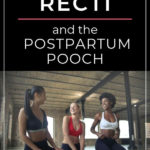The Truth About The Postpartum Pooch: All You Need To Know About Diastasis Recti
Did you know your postpartum pooch might have nothing to do with fat? Scroll through this post to learn all about diastasis recti and what you can do to fix it.

Do you have a “mom pooch”? Does it stick around even with exercise and good nutrition?
Although health and strength are important post pregnancy, the real culprit behind that postpartum pooch might have nothing to do with fat. And if left untreated, it could lead to some other, less-than-pleasant consequences.
Diastasis recti is a condition that happens when you become pregnant. It is not a sign of how much or little you exercised before or during pregnancy. It just happens.
For some women, it goes away on its own, but for many others, it doesn’t. The good news is that it is 100% curable and it’s never too late to fix. Even years after a pregnancy.
MY STORY
After the birth of my 3rd child, I noticed that, along with sporting a nice “mom pooch”, it was harder to fix my posture in my hips and pelvis. I had weird discomfort and pain in my hips and lower back. And I was terrified of having anything more than an empty bladder in public.
I eventually stumbled across some information on diastasis recti and could relate to many of the symptoms. So I took the test. I had a gap of over 3 fingers! (Scroll down for more info on what that means.)
With care and effort, I was able to close the gap. After the birth of my 4th child, though, it came back. But this time, I wasn’t as worried. I knew what to do and I knew it was fixable!
Widespread awareness of diastasis recti is still in its early stages. But it is something I desperately want women to know about. I am not a physical fitness expert, but learning about it over the last few years has been incredibly helpful.
I want to share what I have learned along with what has worked for me. Additionally, I will direct you to the 3 experts that have influenced me the most in my journey toward recovery.
WHAT IS DIASTASIS RECTI?
Diastasis Recti is a separation of the front muscles in your abdomen. Diastasis translates to “separation” and Recti refers to the rectus abdominis ‒ or the 6-pack abs.
When women grow during pregnancy, the stomach muscles separate vertically, creating a gap down the middle. This leaves only a thin connective tissue holding the internal organs inside. In addition, the same pregnancy hormones that cause the ligaments and joints to loosen can cause this tissue to become weak.
Many women find that this gap closes on its own after pregnancy. But some studies show that as many as 40% of women still have the separation 6 months later.
Diastasis recti that continues beyond 6 months doesn’t resolve on its own. But proper and conscious care can heal it completely.
AM I AT RISK FOR DR?
Diastasis recti (DR) lasting beyond 6 months can happen to anyone who is pregnant. It can even be found in men and babies. But it is most likely if:
- You’ve had multiple pregnancies
- Your children are close in age
- You are over 35
- Your baby had a high birth weight
- You carried twins, triplets, etc.
Though DR can happen to anyone who becomes pregnant, there are a few factors that can make it more likely:
- Weak core before pregnancy
- Heavy abdominal exercises during the 2nd and 3rd trimesters of pregnancy
- Beginning heavy abdominal exercises too soon after delivery
WHAT ARE THE SIDE EFFECTS?
The commonly named “mom pooch” is not the only result of DR. Besides still looking pregnant, you may experience:
- Lower back pain
- Hip pain
- Pelvic pain
- Poor posture
- Pain during daily movement (like getting out of bed or lifting heavy objects)
DR is also directly related to a weakened pelvic floor since the two parts of the body work together. This can lead to:
- Urine leaking (especially when sneezing, jumping or standing quickly)
- Constipation
- Hernia (in extreme cases)
- Pelvic organ prolapse (in extreme cases)
Learning about DR and taking action to correct it can have even more benefits that just the aesthetics.
HOW CAN I CHECK FOR DR?
When you lay on your back and lift your head, or when you try to sit up, do you ever see a ridge or “football” protruding from your stomach? Does it disappear when you relax?
There is a simple method to check if you have DR. You can do this yourself, or have someone help you. You will be checking to see how wide the gap is and how deep it is. DR is usually measured with the fingers.
You can find many helpful videos on YouTube, like this one here. But here is a basic rundown of what to do.
Important: Test on an empty stomach. Checking first thing in the morning would be a great time to do this.
- Lay flat on your back.
- Place your fingers horizontally on your belly button.
- Without contracting your ab muscles, lift your head slightly. (Slowly. And don’t stay up too long.)
- Determine how many fingers fit into the gap. 1-1/2 fingers is normal. 2-4 is DR.
- Repeat an inch above the belly button.
- Repeat an inch below the belly button.
HOW DO I TREAT DR?
In many cases, DR resolves on its own a few months after pregnancy. If it is still present 6 months or later, it needs treatment.
Diastasis Recti is not something usually taken care of by a doctor. It is still an emerging awareness and most doctors won’t treat it.
Surgery is available, but should be used as a last resort and only for extreme cases. Additionally, the surgery is considered cosmetic and is not usually covered by insurance.
But a “mommy tummy” isn’t something you have to just accept. The good news is that it can be completely healed with proper care and strengthening.
You can find physical therapists and certified trainers who specialize in DR. There are also programs you can purchase online.
But there are measures you can take, completely on your own (for free) to work toward healing your core. Knowing how to strengthen the proper muscles and what moves to avoid during healing are key to saying goodbye to the “pooch” forever.
MOVES TO AVOID
This comes first. No healing can take place if your DR is continually made worse by certain moves.
IN EVERYDAY MOTION:
- Lifting heavy objects without proper support
- Straining in constipation
- Twisting motions
- Sitting straight up out of bed (try a log roll motion instead)
- Anything that puts extra strain on the abdomen
IN EXERCISE:
- Anything in the plank position
- Traditional ab exercises such as sit-ups and crunches
- Anything with twisting or “jack-knife” motion (i.e. Russian twists or bicycles)
- Leg lifts
- Many Pilates moves
- Yoga poses that stretch or twist the belly
- Be aware of pull-ups, chin-ups, lat pull-downs or anything that makes the stomach cone in the middle.
WHAT TO DO INSTEAD
When trying to heal DR, strengthening the transverse abdominals (TVA) and the obliques is essential. The TVA is a deep muscle and can be hard to activate if you haven’t isolated it before.
This is the video that helped me learn to locate my TVA. Learning how to do TA breathing is also important. It can be done anywhere (even while driving!). Learn how to do that here.
There are many exercises you can use to strengthen the TVA, obliques and glutes. Here are the ones I found to be the most helpful when I first started my recovery.
When I start to notice my posture slipping again or any pain/discomfort in my abs or low back, I add these into my routines again. Note: all of these exercises were taken from certified DR specialists.
Do 3 rounds of each exercise with 10 repetitions each.
EXERCISE 1: PELVIC TILTS
- Lay on your back with knees bent and feet flat on the floor.
- While keeping shoulders pressed to the floor, tighten your abs and exhale with TA breathing.
- Tilt your pelvis toward your chest and press the small of your back to the ground.
- Return to neutral position.
EXERCISE 2: KNEE DROPS
- Lay on your back with knees bent and feet flat on the floor.
- Activate the TVA.
- With legs still bent, lower your right knee to the ground in a clam motion.
- Repeat with the left leg.
EXERCISE 3: HEEL SLIDES
- Lay on your back with knees bent and feet flat on the floor.
- Activate the TVA.
- Slowly slide the right heel out until the leg is straight.
- Return to bent position.
- Repeat with the left leg.
EXERCISE 4: ARM SLIDES
- Lay flat on your back with legs extended straight and arms extended overhead (on the ground).
- Activate the TVA.
- While keeping your arms on the floor, bend and slowly slide your elbows down your sides and toward your hips. (Don’t arch your back.)
- Slowly slide them up to the original position.
EXERCISE 5: ARM DROPS
- Lay flat on your back with knees bent and feet flat on the floor.
- Extend arms straight up over your shoulders (toward the ceiling).
- Activate the TVA.
- While exhaling, slowly lower straightened arms to the ground above your head.
- Keep the TVA activated as you return to the starting position.
EXERCISE 6: EXTENDED DEAD BUG
- Lay on your back with arms extended straight up over your shoulders (toward the ceiling). Bend your knees in a tabletop position with knee at a 90° angle.
- Activate the TVA.
- Slowly lower the right arm over head and extend the left leg out straight.
- Return to the starting position.
- Repeat with the left arm and right leg.
- This is an advanced exercise. Wait until you can keep your pelvis tilted and your back from arching.
EXERCISE 7: GLUTE BRIDGE
- Lay on your back with knees bent and feet flat on the floor.
- Tilt your pelvis toward your chest and activate the TVA.
- Push with your heels to lift glutes off the ground.
- Keep the TVA activated (don’t arch your back).
- Return to starting position.
These moves are excellent when you are just starting DR recovery. For them to be fully effective, make sure you are pressing the small of your back to the ground and activating your TVA the entire time. And as with any exercise, use caution and consult a doctor before beginning a regime.
As you get stronger, there are more advanced exercises you can try. For the very best moves to strengthen your core and heal DR, there are 3 Instagram accounts you can try.
These are the ladies I personally have used to help me in my recovery.
They are incredibly knowledgeable, and are invaluable resources for DR recovery along with the overall strengthening of the core and body.
INSTAGRAM ACCOUNTS TO FOLLOW
- Andrea Allen from Deliciously Fit N Healthy has an account PACKED with information. She is real and shares everything from her strong muscles to her loose skin. She has pre and post natal training programs and offers coaching as well.
- Lorraine Scapens is the founder of the top pre and post natal exercise program in New Zealand, Pregnancy Exercise.
- Julia Baird from Our Fit Family Life focuses almost solely on DR with beginning to advanced core strengthening exercises.
WHAT ABOUT POSTPARTUM BELLY WRAPS?
There are varying opinions on this topic. I have found that most DR specialists don’t recommend wrapping or binding. Although it can be worn for small periods, it doesn’t fix the problem.
Wrapping can cause the body to rely on the wrap. Instead, the body needs to relearn how to locate and activate the correct muscles.
CONCLUSION
Diastasis Recti is not a sign of how hard you worked before or during your pregnancy. It is just something that happens. But that being said, you aren’t stuck with the “mom pooch” forever. You also don’t have to live with it’s side effects. (No more being afraid of sneezing in public!)
To sum up, here are the 5 main takeaways:
- Learn how to measure DR.
- Focus on posture (especially in the pelvis) and TA breathing.
- Strengthen the TVA, obliques and glutes.
- Know what moves to avoid.
- Stick with it!
It’s NEVER too late to close the gap caused by DR. All it takes is some conscious effort with the right moves and a little patience. It may take several months but it CAN be completely healed.
And if you like at-home workouts, here are a few more excellent accounts to follow to keep the rest of your body in shape!
What are your favorite ways to strengthen your core post pregnancy?
want to remember this?
PIN IT TO YOUR FAVORITE BOARD
Share this article:



ican’t believe I may have just found out what my stress incontinence and urgency may be coming from. Also, the weird pelvic /lumbar pain from the muscles being sore. I think I have Diastasis Recti. I actually looked into a tummy tuck. if I remember, he classified me into something like moderate to severe DR. Now maybe I can finally be pain free … thank you for sharing your knowledge with the online community.
I’m so glad this was helpful! Learning how to heal my own DR helped me so much – good luck!